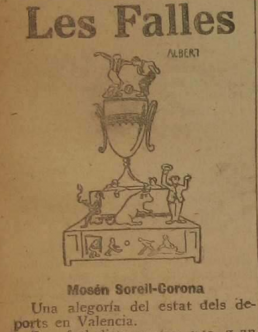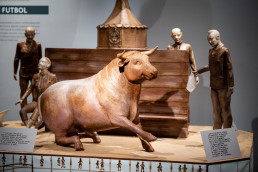“Second blow to football. And it could be called a difficult play, as the players have no more space than the lid of a cup, the cup they are fighting for and which serves as a pedestal. A bullfighter in a bullfighting costume sits on top of the cup, smoking a cigar, without worrying that on the opposite side, a gentleman (perhaps a member of the Divisa?) is about to shoot himself. In the lower part a piece of the barrier, in the alleyway N. and N., characters who do not speak, and in the ring a bull in such a pitiful attitude that, if the sight of him does not put an end to the quarrels between breeders, bullfighters and businessmen, you can say that he has no heart”. This story, published by the newspaper Las Provincias in the edition of Saturday 17 March 1923, was part of the explanation and detailed account of the forty-two fallas planted in the city of Valencia in 1923.
One hundred years later, this falla, which unequivocally exalted the triumph of the discipline of foot-ball over the outdated world of bullfighting, can be seen inside L’ETNO as part of the exhibition DE GRANOTES, GATS I PALMERES, els orígens del Levante UD’. Visitors to this exhibition will be confronted with this monument as soon as they cross the recreation of the Portal de Vallejo that opens the exhibition to enter the room which, by way of an introduction, shows the sporting Valencia of the early 20th century and the sports and different manifestations practised by Valencian society on that threshold of the chronology linked to the birth of Levante FC and Gimnástico FC.
This is a reproduction of the falla built by Regino Mas, one of the main contemporary falla artists. This replica follows the coordinates of the monument located, between the 18th and 19th of March 1923, in the Plaza de Mosen Sorrell, a few metres from the current location of the Museum of Ethnology of Valencia, at the beginning of Corona street, on the premises of the old Beneficencia. The constructive fidelity is absolute, although the dimensions are somewhat smaller than the original in order to adapt the present project to its museum setting. There is respect for the chosen theme and the chosen protagonists. The scenes and dialogues maintain their essence. In this sense, there are no substantial variations with the model that was created in the 1920s. The main difference lies in the choice of colour. A monochrome shade of brown prevails in the current model and pervades the entire monument. This colouring does not correspond to the original traces.
The black and white photos of this falla, the illustrations, also free of colour, published in various local media, and the initial project, which forms part of the documentation held by the City Council, have not allowed us to discover the range of contemporary colours. “Una alegoría del estat dels deports en Valencia” (An allegory of the state of sports in Valencia), was the headline in the Diario de Valencia on Sunday 18 March 1923 at the beginning of the description of the Falla Mosén Sorell-Corona. The argument of this falla was recurrent from a general point of view. The struggle between football and the national bullfighting festival attracted the attention of the Valencian written media in the 1920s. The editorials were repeated.
This discipline, which came from the Anglo-Saxon world, threatened to eclipse an atavistic tradition that survived in the Hispanic imagination. Sport was a hallmark of modernity for the wealthier social strata. And football did not take long to become part of Valencian society. “We had taken for granted that this year our falleros would coincide in their choice of themes, and that the main argument would be the exaltation of football and the overthrow of the Fiesta Nacional, and although this has happened, as the curious reader will see, we could not imagine that there would be so many coincidences” described Las Provincias on Saturday 17th March 1923. According to this prestigious newspaper, “the new sport” was the plotline chosen by many of the contemporary Fallas monuments planted that year. Perhaps there was no better archetype to understand the remarkable development and evolution of football and its capacity to corner entrenched disciplines in time than to re-edit this struggle from the social perspective recreated by the world of the fallas.


